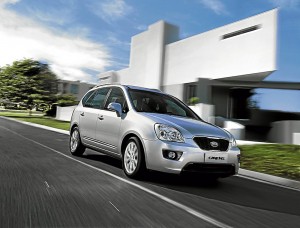
THE CARENS has a very European look and feel to it: the bold mesh radiator grille up front, the relatively low-riding (for an MPV) ride height, chunky tires on nice alloy wheels and hints of black mixing with the chrome.
We’re approaching the peak of summer and that means sizzling temperatures, followed by the intrinsic desire to cool down. Since we’re blessed with 7,107 islands, we get with it a wide variety of beautiful and scenic places to visit. I am an ardent believer that a real journey should include 4-wheeled transportation over land. Hence it’s no wonder I decided to take a closer look at Kia’s Carens, a perfect vehicle for everyday motoring for your typical Filipino family.
Much like last week’s Chevrolet Orlando, the Kia Carens represents the best ideas (or compromises) of traditional everyday motoring, with a hint of forward-looking ingenuity: build a basic 2-box design vehicle that seats seven, has a versatile interior that allows prodigious amounts of cargo to be loaded up, is powered by a fuel-efficient and clean-burning CRDi diesel engine with VGT, decently enjoyable to drive, and most of all, has exterior dimensions comparable to a c-segment sedan.
Kia’s designers and engineers pretty much succeeded with the Carens. Introduced in 2006, the 2nd generation Carens is built and sold all over the world in various nameplates. It shows that KIA was ahead of its time, designing an MPV to go head-on with the MPV’s of Renault, Citroen, VW and Fiat in Europe.
It’s only now that the Asean and Philippine market in particular have begun to see the aforementioned values of an MPV. It offers more space, comfort, convenience and ease of entry and exit than a typical sedan, has slightly better ground clearance, better for our rough roads, yet has none of the bulk and mass of a typical 7-seat SUV, which for the less physically endowed driver, can be quite taxing to drive every day, and daunting as the dimensions make it a chore to maneuver at tight car parks.
The Carens has a very European look and feel to it: the bold mesh radiator grille up front, the relatively low-riding (for an MPV) ride height, chunky tires on nice alloy wheels and hints of black mixing with the chrome. Inside, the interior is a departure from the traditional Japanese-car feel: the shifter for the transmission is the most obvious difference, mounted practically on the dashboard rather than a center console which frees up interior space better. It also means more of the vehicle controls are within easy reach, making motoring hassle-free and even more convenient.
The ride is also Euro-firm: body roll is well-controlled but offers a very compliant ride, perfect for high-speed cruising. The 2.7 meter wheelbase helps as well in giving high-speed comfort and stability. The engine, a 2.0-liter CRDi equipped engine with variable geometry turbine produces a modest 140 ps and more importantly 31 kg-m of torque. It doesn’t seem much, but it makes good use of the 55-liter fuel tank, propelling the Carens down the SLEX at an alarmingly quick rate, enough to surprise a first-time Carens driver. The throttle has a very progressive action with good response; flooring it emits a bit of black smoke and the speed rises quickly, thanks to the rev-happy diesel engine. The steering feel is rather disappointing: it feels like lead, but at least weighs up evenly as speeds increase and is very accurate and responsive, if not laden with good feel and feedback.
The top-spec EX variant is also loaded with a 4-channel ABS brakes and dual airbags plus an automatic door unlocking system in the event of an accident. It also differentiates itself from lower variants by more body-colored trim-work plus a 2DIN multi-media system with MP3, Shiftronic manual override control for the 6-speed A/T and heated side mirrors plus bigger 6.5 X 16 inch alloy wheels on 205/60R16 all-season touring tires.
In the city, the Carens is easily maneuvered into tight spaces, and weaving through traffic is surprisingly easy given the slightly raised ride height and better view ahead. Perfect for the school-run, and with kids, you can make full-use of the two tiny seats at the back. Adults will otherwise have a difficult time fitting in the back and is best suited for short trips only.
Fuel economy is a decent 8 km/liter on a combined city and highway driving, preferably filled up with premium diesel fuel to get the most power and keep the CRDi system clean and efficient for the long run. I would say 5 people will be very comfortable inside the Carens on a long drive as far down south as CamSur, or up north to Pagudpud in continuous driving. It’s very effortless, surprisingly quick, amusingly athletic given its porky weight of 1760 kg and very enjoyable to drive as MPV’s go. Which, as we all know, is crucial in organizing a long summer road trip with the family or barkada. The car has to be safe, reliable and enjoyable to use, and the Carens meets these requirements easily.
The top-spec model is priced keenly at just under P1.2 million, comparable to the newer and better equipped Chevrolet Orlando (a diesel Orlando is available in other markets, let’s hope it gets here soon as well). But the Kia’s diesel engine makes it more attractive to buyers despite the Carens’ aging looks. Rumors say that an all-new Carens is just around the corner, and it will most likely be a looker given the trend of Peter Schreyer-designed Kias, but the current one is still pretty good.